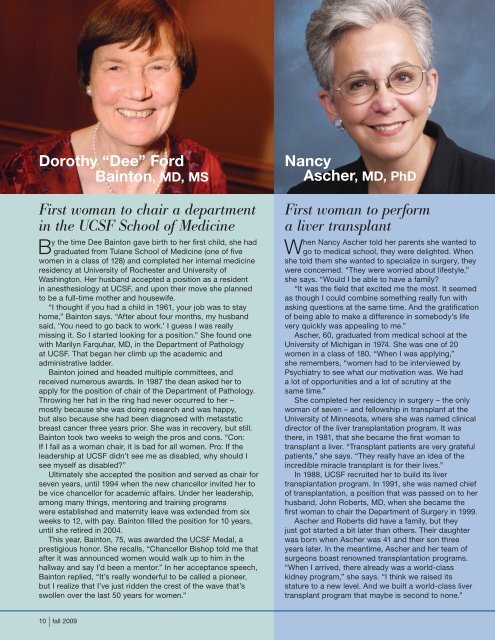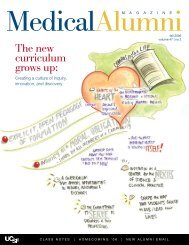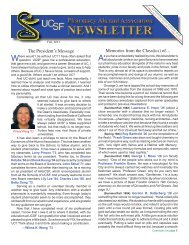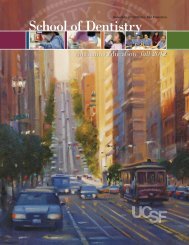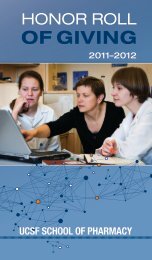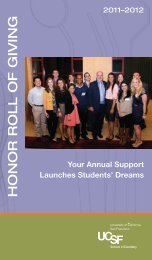here - UCSF Alumni
here - UCSF Alumni
here - UCSF Alumni
Create successful ePaper yourself
Turn your PDF publications into a flip-book with our unique Google optimized e-Paper software.
Dorothy “Dee” FordBainton, MD, MSFirst woman to chair a departmentin the <strong>UCSF</strong> School of MedicineBy the time Dee Bainton gave birth to her first child, she hadgraduated from Tulane School of Medicine (one of fivewomen in a class of 128) and completed her internal medicineresidency at University of Rochester and University ofWashington. Her husband accepted a position as a residentin anesthesiology at <strong>UCSF</strong>, and upon their move she plannedto be a full-time mother and housewife.“I thought if you had a child in 1961, your job was to stayhome,” Bainton says. “After about four months, my husbandsaid, ‘You need to go back to work.’ I guess I was reallymissing it. So I started looking for a position.” She found onewith Marilyn Farquhar, MD, in the Department of Pathologyat <strong>UCSF</strong>. That began her climb up the academic andadministrative ladder.Bainton joined and headed multiple committees, andreceived numerous awards. In 1987 the dean asked her toapply for the position of chair of the Department of Pathology.Throwing her hat in the ring had never occurred to her –mostly because she was doing research and was happy,but also because she had been diagnosed with metastaticbreast cancer three years prior. She was in recovery, but still.Bainton took two weeks to weigh the pros and cons. “Con:If I fail as a woman chair, it is bad for all women. Pro: If theleadership at <strong>UCSF</strong> didn’t see me as disabled, why should Isee myself as disabled?”Ultimately she accepted the position and served as chair forseven years, until 1994 when the new chancellor invited her tobe vice chancellor for academic affairs. Under her leadership,among many things, mentoring and training programswere established and maternity leave was extended from sixweeks to 12, with pay. Bainton filled the position for 10 years,until she retired in 2004.This year, Bainton, 75, was awarded the <strong>UCSF</strong> Medal, aprestigious honor. She recalls, “Chancellor Bishop told me thatafter it was announced women would walk up to him in thehallway and say I’d been a mentor.” In her acceptance speech,Bainton replied, “It’s really wonderful to be called a pioneer,but I realize that I’ve just ridden the crest of the wave that’sswollen over the last 50 years for women.”NancyAscher, MD, PhDFirst woman to performa liver transplantWhen Nancy Ascher told her parents she wanted togo to medical school, they were delighted. Whenshe told them she wanted to specialize in surgery, theywere concerned. “They were worried about lifestyle,”she says. “Would I be able to have a family?“It was the field that excited me the most. It seemedas though I could combine something really fun withasking questions at the same time. And the gratificationof being able to make a difference in somebody’s lifevery quickly was appealing to me.”Ascher, 60, graduated from medical school at theUniversity of Michigan in 1974. She was one of 20women in a class of 180. “When I was applying,”she remembers, “women had to be interviewed byPsychiatry to see what our motivation was. We hada lot of opportunities and a lot of scrutiny at thesame time.”She completed her residency in surgery – the onlywoman of seven – and fellowship in transplant at theUniversity of Minnesota, w<strong>here</strong> she was named clinicaldirector of the liver transplantation program. It wast<strong>here</strong>, in 1981, that she became the first woman totransplant a liver. “Transplant patients are very gratefulpatients,” she says. “They really have an idea of theincredible miracle transplant is for their lives.”In 1988, <strong>UCSF</strong> recruited her to build its livertransplantation program. In 1991, she was named chiefof transplantation, a position that was passed on to herhusband, John Roberts, MD, when she became thefirst woman to chair the Department of Surgery in 1999.Ascher and Roberts did have a family, but theyjust got started a bit later than others. Their daughterwas born when Ascher was 41 and their son threeyears later. In the meantime, Ascher and her team ofsurgeons boast renowned transplantation programs.“When I arrived, t<strong>here</strong> already was a world-classkidney program,” she says. “I think we raised itsstature to a new level. And we built a world-class livertransplant program that maybe is second to none.”10 | fall 2009


